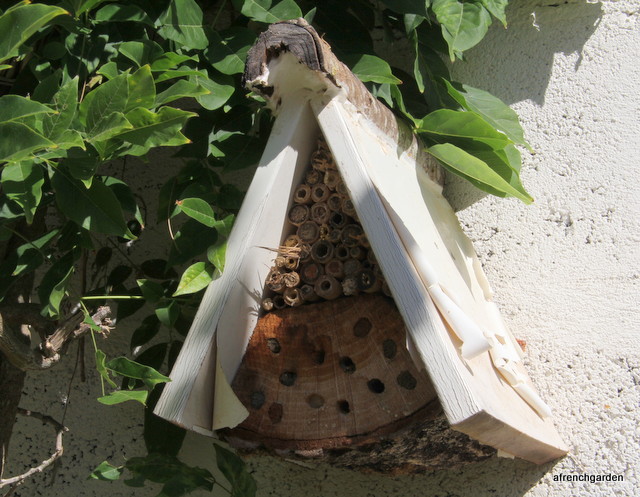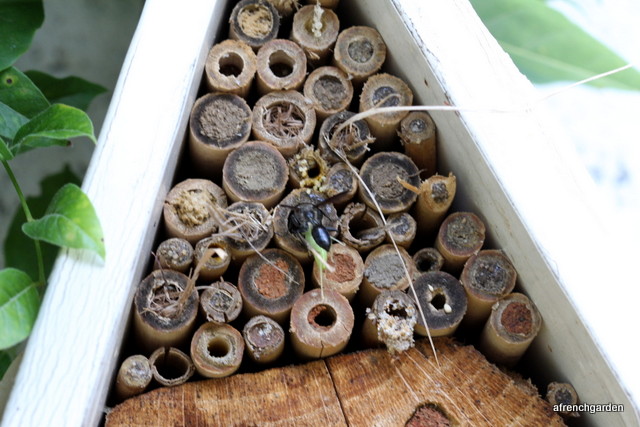I keep my bee hotels in full sun so that this gives me maximum light for photographing the antics of the visitors and the warm site appears to be appreciated by the bees. This has worked well until this summer when the high temperatures and hot sun have kept me from watching as much as I would have liked to.
Look what has happened when I have not been watching! I have never heard of a bee building a nest out of straw and I could not imagine any small insect flying in with so much straw. My husband suggested it might be a very small bird, he was joking, but it did look more like a bird building a nest than a bee.
Then there was the heaps of pollen under the hotel. It looked as if something might be turfing out the contents of a previously built nest.
As today was cooler (under 30 degrees Centigrade, just) I had to see if I could see what was happening. I was rewarded by seeing, not a bee but an elegant wasp-shaped “thing” (I.D. anyone?).
I could see by looking at it that bad times loomed ahead. Perhaps impending destruction of my bees by this strange creature. However, I wanted to make sure that this was the straw importer and I wanted to see for myself how she could bring the straw.
My patience was rewarded and I saw her bring back some straw but it was not until I looked at the photographs that I realised she was holding something else in addition.
Not only had she managed to bring back the straw but she was also carrying a hapless caterpillar.
At this point my reasoning did a U-turn. Sorry caterpillar, and all that, but if you are going to be the food for the wasp larvae it means that my bees are safe. I don’t mind if your eggs are tucked up inside your strange straw bed, as long as your larvae are not eating my bee larvae.
So that just leaves the pollen mystery. But what is this cute little bee doing inside a cane that was sealed by an Osmia this spring and on target to hatch out next spring? It looks like a Heriades to me and these little bees seem to make free and easy with other bees provisions (see “Je t’accuse“) but I may be mistaken.
And I was mistaken about the sombre, black wasp that I thought was a parasite. Instead she looks like a gardeners friend. She can have as many caterpillars from the garden as she likes (sorry, butterflies, everybody has different priorities) and is very welcome in the bee hotels.
So before you think about swatting anything in the garden, pause and consider – you may be mistaken.
Saturday 25 July 2015, I’d just like to add a postscript for anyone who is interested. The wasp has been identified by Susan Walter of Days on the Claise (http://daysontheclaise.blogspot.fr/ ) as an Isodontia mexicana (https://en.wikipedia.org/wiki/Isodontia_mexicana).









It seems like straw would be awfully heavy for a wasp, but obviously not. I can’t imagine what it does with it.
Nature is always full of surprises!
LikeLike
She seems to do the same thing as the Osmia bees and blocks the entrance to her nest with it. The caterpillar will provide nourishment for her young but what I don’t know is whether they will hatch out next year like the Osmia bees or later this year. I would guess that in a straw house they would be safer to come out before winter. Amelia
LikeLike
What a pretty ‘wasp-shaped thing’!
LikeLike
She has an elegant dark style. Amelia
LikeLike
This Hornet looks like one of the Sphecid wasps, harmless to people, but as you’ve seen it does feast on insects (I’m not sure whether that means bees, but I doubt it seeing she has gone to so much effort to catch a caterpillar when bees are all around her)
LikeLike
I think big juicy caterpillars are what she needs to provision her nest. My bees are safe and so am I. Thanks for the I.D. I don’t suppose we will get any nearer than the genus Sphecidae. Amelia
LikeLike
Susan Walter has just identified it as Isodontia mexicana – a grass-carrying wasp.
LikeLiked by 1 person
Since keeping bees, I have learned to tell the different sounds of the flying critters when I work in the garden. Low bee hum–no swatting, winding buzz of a deer fly–swat away (though if you’re patient and let it land, you can usually get it before it takes its big bite), and the tiny whine of a black fly…maybe it’s time to go in for a while.
LikeLiked by 1 person
I know just what you mean, it is not only your eyes but your ears are open in the garden now. Amelia
LikeLike
Given the seemingly vast number of hole-nesting species you seem to get visiting…
perhaps K ought to take a break from the bees and make a load more of these nests.
And I’ll bet Susan will be in with the ident on the wasp pretty rapidly…
once she’s finished tidying up after yesterdays b/d party for Simon!
And I know she’s busy today….
BTW…That long overdue glow-worm post might get on the interweb this week…
if I get the chance this evening?????
LikeLike
Actually, since the Osmia I feel the nests are being less occupied this year and I feel I have been seeing less bees and bumbles since this winter time. All feelings though at the moment. Amelia
LikeLike
Interesting…
I have the same feeling about the drilled nest blocks….
there are certainly less holes filled in two of them…
but I am now wondering if they don’t like to use “dirty” holes…
all the obviously empty ones were used last year.
it must waste a lot of energy for small insects clearing out last year’s tubes in order to re-lay….
when there are perfectly good “fresh” holes next door.
I’ll take a photo of some and overlay the pix on last year’s corresponding ones….
to check which holes are filled?
LikeLike
I have a lovely new nest this year with plenty of space unused by the early Osmia so that is not my problem. The early Osmia don’t mind re-using old holes. I suppose it could depend on availability as to whether old or new holes are used. Honey bees actually prefer used comb to lay in.
LikeLike
Fascinating, Amelia, and it looks like your hotel has pretty good occupancy rates this year!
BW
Julian
LikeLike
Actually, this year I am seeing less Megachiles of the leaf cutting type, I am not sure why. Amelia
LikeLike
They must all be over here in Surrey, Amelia – I’ve noticed them using our bee house for the first time this summer!
LikeLike
Congratulation, very jealous! Still no sign of them nesting here this year and I have a new hotel as well as used holes. Amelia
LikeLike
Very interesting as always! Have you thought about putting your pictures on one of the ID sites?
LikeLike
I did not need to! Susan Walter has already identified it and I have now modified the post to show the I.D. as Isodontia mexicana – a grass-carrying wasp. I am very lucky that Susan takes an interests in the posts. Amelia
LikeLike
Amazing Amelia, as always! The wasps that make their nests out of earth here put live spiders inside to feed their larvae, as there seem to be innumerable spiders I rather admire the wasp, although the fact that the spiders are alive when eaten is rather gruesome.
LikeLike
My logical side says all creatures are equal but the other side is not too keen on spiders, ants and bee-eating hornets. Amelia
LikeLiked by 1 person
The black wasp is a Grass-carrying Wasp Isodontia mexicana, not native, but a nice polite immigrant which is not a problem. Congratulations on getting some good shots of it in action. I’ve never managed to.
LikeLike
Thank you once again Susan for coming up with an I.D. I had never heard of a grass carrying wasp. It is another example of how the different species are moving around the world. Amelia
LikeLike
I went to a seminar on native bees (in Australia) recently and a woman gave a talk on a study she’d been doing on pollinators in the Sydney surrounds. One of the things she did was set-up and then check bee hotels. I can’t remember the exact figure but it was something like 80% wasps. Wasps do love our bee hotels 🙂
LikeLike
Wasps must be as fascinating a group to study as bees, but I think they generally have a very poor P.R. compared to bees. It is true bees pollinate but the pollination by wasps is probably underestimated and in addition a lot of them act as very efficient pest control agents for gardeners and farmers. Amelia
LikeLike
The bee hotels are such interesting things. Imagine catching that wasp in the act, you must have been delighted.
LikeLike
Late to this (after a week in the Jura), but glad to have seen it. What an extraordinary variety of winged life inhabits your hotel. I have to keep up, so I can ID things that (might) arrive at ours… RH
LikeLiked by 2 people